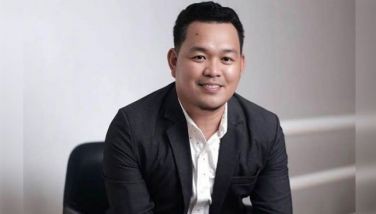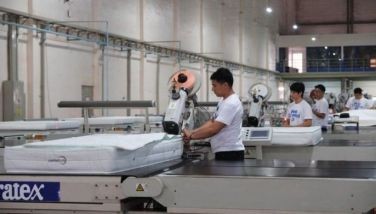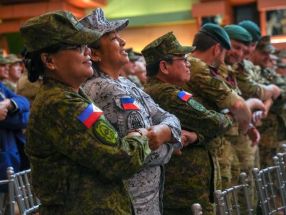People empowerment

There was no prominent event on Feb. 22 to mark the start of the commemoration of the four-day 1986 people power revolt.
Instead the Sandiganbayan junked another forfeiture case filed against spouses Ferdinand and Imelda Marcos and their alleged cronies.
The only son and namesake of Ferdinand Marcos at least did not abolish the national holiday on Feb. 25. Ferdinand “Bongbong” Jr. moved the holiday observance to Feb. 24, today, for a long weekend.
BBM has said he sees nothing to apologize for in connection with his father’s regime. Also, his campaign team in 2022 had stressed that the sins of the forebears must not be visited upon him – even if he is the administrator of the Marcos estate that incidentally still owes the government billions in estate taxes.
Many years ago, long before anyone could imagine the Marcoses making a political comeback, I got into a conversation with a prominent foreign diplomat, on why the same social and political ills persisted in the Philippines despite two people power revolts that resulted in leadership changes.
He said, seriously, that perhaps it was because both revolts were bloodless and peaceful.
I’ve heard similar observations over the years from diplomats and expats from some other countries that underwent violent, bloody upheavals on their way to modern statehood. The prolonged bloodshed, they said, seemed to intensify not only the desire for enduring peace, but also the determination to set things right and make peace work.
Peace advocates will be horrified by this observation, and it’s unhealthy to espouse violence as a means to any end. But I’m writing about this to illustrate the conversations revolving, long before Marcos 2.0, around the question: after the original people power revolt, where did the country go wrong?
* * *
Manila Archbishop Jaime Cardinal Sin, who rallied the people to EDSA, sounded an early alarm: he lamented the kanya-kanya mentality that prevailed in the aftermath of the people power euphoria. Instead of disappearing, kanya-kanya – to each his own – has become even more firmly entrenched, 37 years after the revolt.
Ages ago, we stopped commemorating the second people power revolt in January 2001 that replaced Joseph Estrada less than halfway through his term with his vice president, Gloria Macapagal Arroyo.
EDSA Dos has become like a dirty family secret. No need for historical revisionism on this revolt; it has become an unmentionable among those who remain enamored with people power.
In fact the string of corruption and poll fraud scandals during the nine years under GMA reinforced people power fatigue.
Fighting corruption and the wang-wang VIP entitlement mentality became battle cries of the second Aquino presidency. But Noynoy Aquino’s stint was hounded, unfairly or not, by perceptions of uncaring elitism by the landowning class. Not even the tricyle padyak and tsinelas campaigns of his moneyed bestie and endorsed successor could dispel such perceptions.
The winds of change in the public mood could be felt even when the death of Cory Aquino propelled her only son to the presidency in 2010. That same year saw the election of a Marcos to a national post for the first time, when BBM won a Senate seat. But perhaps because an Aquino was in power, people didn’t see the trajectory of the Marcos rehabilitation effort.
The upward trajectory was anchored on public disenchantment with the lack of improvement in the quality of life of the majority of Filipinos.
* * *
After the 1986 revolt, poverty persisted, with the concomitant poor health, lack of proper nutrition that causes physical and mental stunting, undereducation and general lack of opportunities in life. We have failed in people empowerment.
Human underdevelopment undermines so many critical aspects of life, from the choices we make in elections, the quality of governance and national competitiveness.
Post-EDSA, it seemed to many that the rich simply got richer and the poor, poorer. Each new administration had its own cronies or favored oligarchs (as described by Rodrigo Duterte), or created new ones. Politics remained as self-serving as ever.
Elections, with the need to fill empty pockets and stomachs driving the vote, seemed to simply pave the way for a transfer of power from one bunch of navel-gazing crooks to another.
Duterte’s dramatic rise to power was not entirely a repudiation of the EDSA 1 forces. He was, after all, endorsed by EDSA hero Fidel Ramos. And administration candidate Leni Robredo won as vice president, although it was noteworthy that she defeated closest rival Bongbong Marcos at the time only by the skin of her teeth.
Also noteworthy is that Duterte was first appointed to a local government post (as Davao City OIC vice mayor) by Corazon Aquino during her revolutionary government.
* * *
Duterte, however, openly resented the efforts of groups and entities he associated with the “yellow” forces to undermine his 2016 campaign. He used the powers of the presidency to hit back.
At the same time, he reached out to the masses, expanding the conditional cash transfer program and providing free universal health care (still not fully rolled out today), universal free education from kindergarten to college, mental health and HIV / AIDS assistance. Never mind if limited funding translated into poor quality of free services.
The outcome of the midterm elections in 2019 should have put the opposition, which suffered a shutout, on crisis mode. Instead kanya-kanya still prevailed in the 2022 race, and unsurprisingly, divided they fell.
Inevitably, the results of last year’s polls are seen as the culmination of the repudiation of the 1986 revolt. The opposition is now leaderless.
Still, the country isn’t quite back to square one. BBM seems bent on showing the world that he’s no autocrat like daddy dearest. Democracy, even if it has huge warts in this country, is in place. There has been no return to authoritarian rule. Even if Duterte enjoyed high support for his brutal approach to law enforcement and his ideas about human rights, he presided over a peaceful handover of power, making good on his promise not to spend even a minute beyond his term as president.
The results of a Social Weather Stations survey taken Dec. 10 to 14, 2022 should give people power believers hope. It showed that 62 percent of Filipinos believe the spirit of EDSA 1 is still alive.
Harnessing this spirit for people empowerment is the challenge.
- Latest
- Trending























